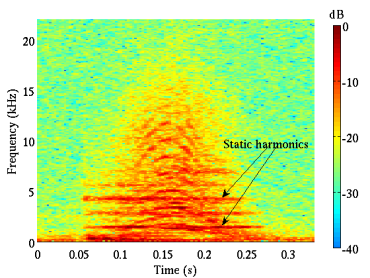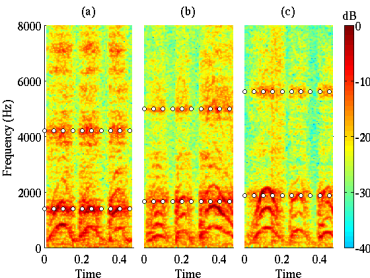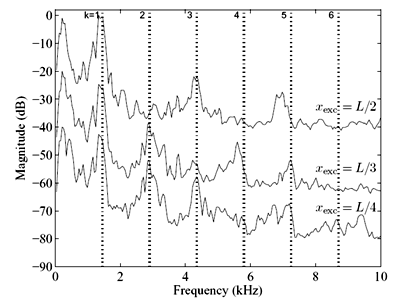A spectrogram figure of the handling noise created by
sliding a finger on a wound guitar string is presented below. A 12 ms Hamming analysis
window was used with 75 % overlap. The noise clearly has a harmonic
structure, where the frequency and amplitude of the harmonics
increase with the sliding velocity. In addition to the moving
harmonics, static harmonics (denoted by arrows) can be found in the
spectrum. Click
here to hear the sound (played three times).

Spectrograms of the scratch noise on the damped 6th string of an
acoustic guitar are presented below. A 23 ms Hamming window with 75
% overlap was used in analysis. The string was scratched with a
fingertip, while (a) it had an open length. In (b) and (c), a capo
was applied (b) at the third and (c) at the fifth fret. In (a), the
dotted white line illustrates the frequency of the 1st and 3rd
static harmonics (1400 Hz and 4200 Hz, respectively). In (b) and (c)
the white line denotes the frequency where the static harmonics
should be located if they were a function of the length of the
string. As can be seen, the static resonances coincide well with the
dotted lines.
Click here to hear examples (a)
through (c) played one after another (with short gaps in between).
The variation in the longitudinal mode frequencies between samples (a)-(c)
can be heard as a timbral change.

The figure below illustrates the averaged power spectrum of the
handling noise when the 6th string is scratched at 1/2 (top pane),
at 1/3rd (middle pane), and at 1/4th (bottom pane) of the length of
the string. A magnitude offset of 20 dB was applied to the spectra,
for clarity. An averaging window of 23 ms was used. The k values
and the vertical dotted lines denote the longitudinal mode numbers
and locations, respectively. Click here to listen to the different
scratch noises. In the sound example, the string is first scratched
at its midpoint, then after a short break it is scratched at L/3,
and finally after a break the scratching is done at L/4.






